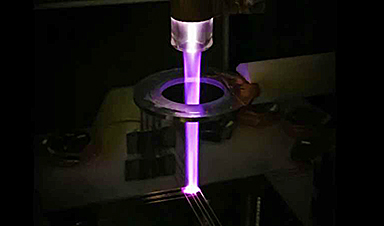Artificially intelligent software has been developed to enhance medical treatments that use jets of electrified gas known as plasma. The computer code predicts the chemicals emitted by plasma devices, which can be used to treat cancer, promote healthy tissue growth and sterilize surfaces.
The plasma studied in the experiments is known as cold atmospheric plasma (CAP). When the CAP jet is turned on, numerous chemical species in the plasma take part in thousands of reactions. These chemicals modify the cells undergoing treatment in different ways, depending on the chemical composition of the jet. While scientists know that CAPs can be used to kill cancer cells, treat wounds and kill bacteria on food, it’s not fully understood why.
“This research is a step toward gaining a deeper understanding of how and why CAP jets work and could also one day be used to refine their use,” said Yevgeny Raitses, a managing principal research physicist at the U.S. Department of Energy’s Princeton Plasma Physics Laboratory (PPPL).
The project was completed by the Princeton Collaborative Low Temperature Plasma Research Facility (PCRF), a collaboration between researchers at PPPL and the George Washington University (GWU).
PPPL has a growing body of work that combines its 70 years of pioneering plasma research with its expertise in AI to solve societal problems. The Lab’s mission extends beyond using plasma to generate fusion power to its use in fields such as medicine and manufacturing, among others.
The software uses an approach known as a physics-informed neural network (PINN). In a PINN, data is organized into parts called nodes and neurons. The flow of the data mimics the way information is processed in the human brain. Laws of physics are also added to the code.
“Knowing what comes out of the jet is very important. Knowing what comes out accurately is very difficult,” said Sophia Gershman, a lead PPPL research engineer from the PCRF who worked on this collaborative project. The process would require several different devices to collect different kinds of information about the jet.
“In practical studies, it is difficult to go and utilize all of the various technologically advanced diagnostics all at once for each device and for various types of surfaces that we treat,” Gershman explained.
Calculating the chemical composition one nanosecond at a time
Li Lin, a research scientist from GWU and the paper’s primary author, said it’s also difficult to calculate the chemicals in a CAP jet because the interactions need to be considered a nanosecond at a time.
“When you consider that the device is in operation for several minutes, the number of calculations makes the problem more than simply computationally intensive. It’s practically impossible,” Lin said. “Machine learning allows you to bypass the complicated part.”
The project began with a small set of real-world data that was gathered using a technique known as Fourier-transform infrared absorption spectroscopy. The researchers used that small dataset to create a broader set of data. That data was then used to train the neural network using an evolutionary algorithm, which is a type of computer code inspired by nature that searches for the best answers using a survival-of-the-fittest approach.
Several successive batches of data are generated using slightly different approaches, and only the best datasets from each round are carried through to the next round of training until the desired results are achieved.
Ultimately, the team was able to accurately calculate the chemical concentrations, gas temperature, electron temperature and electron concentration of the cold atmospheric plasma jet based on data gathered during real-world experiments.
In a cold atmospheric plasma, the electrons—small, negatively charged particles—can be very hot, though the other particles are close to room temperature. The electrons can be at a low enough concentration that the plasma doesn’t feel hot or burn the skin while still being able to have a significant effect on the targeted cells.
On the path to personalized plasma treatment
Michael Keidar, the A. James Clark Professor of Engineering at GWU and a frequent collaborator with PPPL who also worked on this project, said the long-term goal is to be able to perform these calculations fast enough that the software can automatically adjust the plasma during a procedure to optimize treatment. Keidar is currently working on a prototype of such a “plasma adaptive” device in his lab.
“Ideally, it can be personalized. The way we envision it, you treat the patient, and the response of every patient will be different,” Keidar explained. “So, you can measure the response in real-time and then try to inform, using feedback and machine learning, the right settings in the plasma-producing device.”
More research needs to be done to perfect such a device. For example, this study looked at the CAP jet over time but at only one point in space. Further research would need to broaden the work so it considers multiple points along the jet’s output stream.
The study also looked at the plasma plume in isolation. Future experiments would need to integrate the surfaces treated by the plasma to see how that impacts the chemical composition at the treatment site.
More information: Li Lin et al, Data-driven prediction of the output composition of an atmospheric pressure plasma jet, Journal of Physics D: Applied Physics (2023). DOI: 10.1088/1361-6463/acfcc7
News
Nanocrystals Carrying Radioisotopes Offer New Hope for Cancer Treatment
The Science Scientists have developed tiny nanocrystal particles made up of isotopes of the elements lanthanum, vanadium, and oxygen for use in treating cancer. These crystals are smaller than many microbes and can carry isotopes of [...]
New Once-a-Week Shot Promises Life-Changing Relief for Parkinson’s Patients
A once-a-week shot from Australian scientists could spare people with Parkinson’s the grind of taking pills several times a day. The tiny, biodegradable gel sits under the skin and releases steady doses of two [...]
Weekly injectable drug offers hope for Parkinson’s patients
A new weekly injectable drug could transform the lives of more than eight million people living with Parkinson's disease, potentially replacing the need for multiple daily tablets. Scientists from the University of South Australia [...]
Most Plastic in the Ocean Is Invisible—And Deadly
Nanoplastics—particles smaller than a human hair—can pass through cell walls and enter the food web. New research suggest 27 million metric tons of nanoplastics are spread across just the top layer of the North [...]
Repurposed drugs could calm the immune system’s response to nanomedicine
An international study led by researchers at the University of Colorado Anschutz Medical Campus has identified a promising strategy to enhance the safety of nanomedicines, advanced therapies often used in cancer and vaccine treatments, [...]
Nano-Enhanced Hydrogel Strategies for Cartilage Repair
A recent article in Engineering describes the development of a protein-based nanocomposite hydrogel designed to deliver two therapeutic agents—dexamethasone (Dex) and kartogenin (KGN)—to support cartilage repair. The hydrogel is engineered to modulate immune responses and promote [...]
New Cancer Drug Blocks Tumors Without Debilitating Side Effects
A new drug targets RAS-PI3Kα pathways without harmful side effects. It was developed using high-performance computing and AI. A new cancer drug candidate, developed through a collaboration between Lawrence Livermore National Laboratory (LLNL), BridgeBio Oncology [...]
Scientists Are Pretty Close to Replicating the First Thing That Ever Lived
For 400 million years, a leading hypothesis claims, Earth was an “RNA World,” meaning that life must’ve first replicated from RNA before the arrival of proteins and DNA. Unfortunately, scientists have failed to find [...]
Why ‘Peniaphobia’ Is Exploding Among Young People (And Why We Should Be Concerned)
An insidious illness is taking hold among a growing proportion of young people. Little known to the general public, peniaphobia—the fear of becoming poor—is gaining ground among teens and young adults. Discover the causes [...]
Team finds flawed data in recent study relevant to coronavirus antiviral development
The COVID pandemic illustrated how urgently we need antiviral medications capable of treating coronavirus infections. To aid this effort, researchers quickly homed in on part of SARS-CoV-2's molecular structure known as the NiRAN domain—an [...]
Drug-Coated Neural Implants Reduce Immune Rejection
Summary: A new study shows that coating neural prosthetic implants with the anti-inflammatory drug dexamethasone helps reduce the body’s immune response and scar tissue formation. This strategy enhances the long-term performance and stability of electrodes [...]
Scientists discover cancer-fighting bacteria that ‘soak up’ forever chemicals in the body
A family of healthy bacteria may help 'soak up' toxic forever chemicals in the body, warding off their cancerous effects. Forever chemicals, also known as PFAS (per- and polyfluoroalkyl substances), are toxic chemicals that [...]
Johns Hopkins Researchers Uncover a New Way To Kill Cancer Cells
A new study reveals that blocking ribosomal RNA production rewires cancer cell behavior and could help treat genetically unstable tumors. Researchers at the Johns Hopkins Kimmel Cancer Center and the Department of Radiation Oncology and Molecular [...]
AI matches doctors in mapping lung tumors for radiation therapy
In radiation therapy, precision can save lives. Oncologists must carefully map the size and location of a tumor before delivering high-dose radiation to destroy cancer cells while sparing healthy tissue. But this process, called [...]
Scientists Finally “See” Key Protein That Controls Inflammation
Researchers used advanced microscopy to uncover important protein structures. For the first time, two important protein structures in the human body are being visualized, thanks in part to cutting-edge technology at the University of [...]
AI tool detects 9 types of dementia from a single brain scan
Mayo Clinic researchers have developed a new artificial intelligence (AI) tool that helps clinicians identify brain activity patterns linked to nine types of dementia, including Alzheimer's disease, using a single, widely available scan—a transformative [...]





















